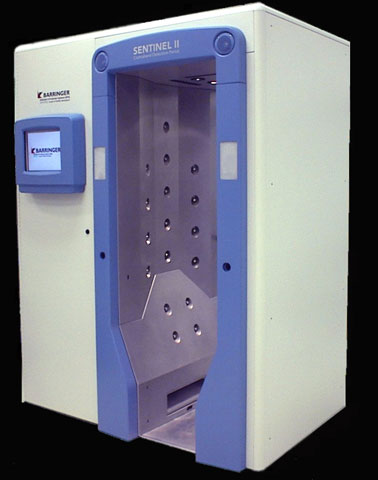
ALBUQUERQUE, N.M. — Explosives-detection technology originally developed at the U.S. Department of Energy’s Sandia National Laboratories is part of a new walk-through airport security tool unveiled today, May 9, during a briefing in Washington, D.C.
The SENTINEL II portal, by Smiths Detection & Protection Systems – Barringer Instruments, makes it possible to non-invasively screen people for the presence of an explosive device with the same technology currently used to screen luggage and freight.

“With the SENTINEL II, it is possible to screen people — not just their bags — with the most advanced explosives detection equipment available,” said Ken Wood, president of Barringer Instruments. “Given the reality of actual and potential suicide bombers, people must be screened thoroughly. The recent shoe bomber incident is just one example of the necessity to screen people using this technology. However, the traveling public expects screening to be quick and non-intrusive. The SENTINEL II solves all of these issues. This technology is proven, affordable, and can be adapted to various settings and applications.”
The SENTINEL II walk-through portal can screen about seven people per minute for a variety of substances and can be used in facilities other than airports, such as office buildings, sports arenas, and other highly trafficked areas, according to Barringer.
Sandia developed and licensed to Barringer the sample preconcentrator used in the SENTINEL II. The technology efficiently traps the target particles and vapors from a large volume of air, then directs the concentrated chemical sample to Barringer’s IONSCAN® detector for analysis, which makes possible the detection of very low concentrations of explosive chemicals.
Headquartered in Warren, New Jersey, Barringer Instruments, a part of Smiths Detection & Protection Systems, is principally engaged in developing and manufacturing high technology products for drug, explosive, and chemical detection and other security and industrial applications. Barringer also operates from facilities in Toronto, the UK, France and Malaysia.
Smiths Aerospace is the leading transatlantic aerospace equipment company, with half its 12,000 staff and $2 billion revenues in North America. Smiths Aerospace, a part of Smiths Group plc, holds key positions in the supply chains of all major military and civil aircraft and engine manufacturers and are world-leaders in electronic systems, actuation systems, precision components, and detection & protection systems.
Barringer news media contact: Cindy Schifano, 908-222-9100 ext. 3031
Paula Darte, 703-704-5135
Smiths Aerospace news media contact: Jennifer Villarreal, 616-241-8643
More information about Sandia’s explosives-detection technology: